Items
Tag
painting
-
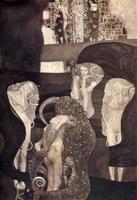 Jurisprudence An allegorical painting.
Jurisprudence An allegorical painting. -
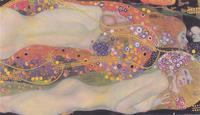 Water Snakes II Two or three women swiming.
Water Snakes II Two or three women swiming. -
 The Bride (Unfinished) Several Figures intertwined in each other with a figure laying alone, unfinished.
The Bride (Unfinished) Several Figures intertwined in each other with a figure laying alone, unfinished. -
 Danae A depiction of the myth of Danae, who is impregnated through a golden shower by the God Zeus.
Danae A depiction of the myth of Danae, who is impregnated through a golden shower by the God Zeus. -
 Hope I A young, pregnant female, surrounded by dark creatures.
Hope I A young, pregnant female, surrounded by dark creatures. -
 Judith and the Head of Holofernes A painting of a myth, Judith who slays Holofernes.
Judith and the Head of Holofernes A painting of a myth, Judith who slays Holofernes. -
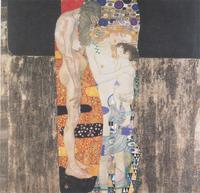 The Three Ages of Woman Three women depicting three ages in the life cycle of a woman.
The Three Ages of Woman Three women depicting three ages in the life cycle of a woman. -
 The Virgin Six women lay intertwined, each representing a stage of life.
The Virgin Six women lay intertwined, each representing a stage of life. -
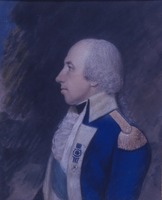 Rufus Putnam Oil painting of Rufus Putnam
Rufus Putnam Oil painting of Rufus Putnam -
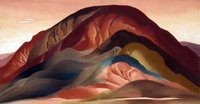 Rust Red Hills Born in 1887, Georgia O'Keeffe was an American artist who painted nature in a way that showed how it made her feel. She is best known for her paintings of flowers and desert landscapes. She played an important part in the development of modern art in America, becoming the first female painter to gain respect in New York's art world in the 1920s. Her unique and new way of painting nature, simplifying its shapes and forms meant that she was called a pioneer.
Rust Red Hills Born in 1887, Georgia O'Keeffe was an American artist who painted nature in a way that showed how it made her feel. She is best known for her paintings of flowers and desert landscapes. She played an important part in the development of modern art in America, becoming the first female painter to gain respect in New York's art world in the 1920s. Her unique and new way of painting nature, simplifying its shapes and forms meant that she was called a pioneer. -
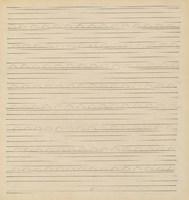 Untitled For more than forty years, Agnes Martin (1912–2004) created serene paintings composed of grids and stripes. With an attention to the subtleties of line, surface, tone, and proportion, she varied these forms to generate a body of work impressive both in its intricacy and focus. Martin’s commitment to this spare style was informed by a belief in the transformative power of art, in its ability to conjure what she termed “abstract emotions”—happiness, love, and experiences of innocence, freedom, beauty, and perfection. This retrospective, her first comprehensive survey in over two decades, presents the scope of Martin’s output, including her biomorphic abstractions of the 1950s, signature grid and stripe compositions, and final paintings. Together these works trace Martin’s practice as she developed and refined a format to express her singular vision.
Untitled For more than forty years, Agnes Martin (1912–2004) created serene paintings composed of grids and stripes. With an attention to the subtleties of line, surface, tone, and proportion, she varied these forms to generate a body of work impressive both in its intricacy and focus. Martin’s commitment to this spare style was informed by a belief in the transformative power of art, in its ability to conjure what she termed “abstract emotions”—happiness, love, and experiences of innocence, freedom, beauty, and perfection. This retrospective, her first comprehensive survey in over two decades, presents the scope of Martin’s output, including her biomorphic abstractions of the 1950s, signature grid and stripe compositions, and final paintings. Together these works trace Martin’s practice as she developed and refined a format to express her singular vision. -
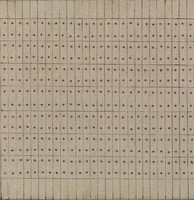 Little Sister For more than forty years, Agnes Martin (1912–2004) created serene paintings composed of grids and stripes. With an attention to the subtleties of line, surface, tone, and proportion, she varied these forms to generate a body of work impressive both in its intricacy and focus. Martin’s commitment to this spare style was informed by a belief in the transformative power of art, in its ability to conjure what she termed “abstract emotions”—happiness, love, and experiences of innocence, freedom, beauty, and perfection. This retrospective, her first comprehensive survey in over two decades, presents the scope of Martin’s output, including her biomorphic abstractions of the 1950s, signature grid and stripe compositions, and final paintings. Together these works trace Martin’s practice as she developed and refined a format to express her singular vision.
Little Sister For more than forty years, Agnes Martin (1912–2004) created serene paintings composed of grids and stripes. With an attention to the subtleties of line, surface, tone, and proportion, she varied these forms to generate a body of work impressive both in its intricacy and focus. Martin’s commitment to this spare style was informed by a belief in the transformative power of art, in its ability to conjure what she termed “abstract emotions”—happiness, love, and experiences of innocence, freedom, beauty, and perfection. This retrospective, her first comprehensive survey in over two decades, presents the scope of Martin’s output, including her biomorphic abstractions of the 1950s, signature grid and stripe compositions, and final paintings. Together these works trace Martin’s practice as she developed and refined a format to express her singular vision. -
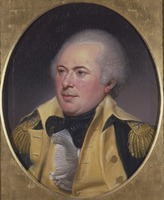 James Wilkinson Painting of James Wilkinson
James Wilkinson Painting of James Wilkinson -
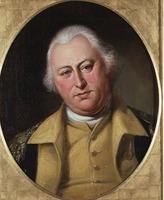 Benjamin Lincoln Painting of Benjamin Lincoln
Benjamin Lincoln Painting of Benjamin Lincoln -
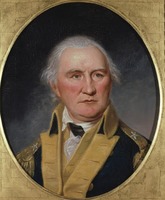 Daniel Morgan Painting of Daniel Morgan
Daniel Morgan Painting of Daniel Morgan -
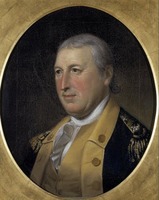 Horatio Gates Painting of Horatio Gates
Horatio Gates Painting of Horatio Gates -
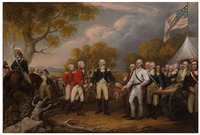 The Surrender of General Burgoyne at Saratoga, October 16, 1777 A painting by John Trumbull depicting the Surrender of General Burgoyne at the Battle of Saratoga
The Surrender of General Burgoyne at Saratoga, October 16, 1777 A painting by John Trumbull depicting the Surrender of General Burgoyne at the Battle of Saratoga -
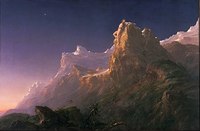 Prometheus Bound “In classical mythology, Prometheus was an immortal giant who aided the human race by stealing fire from the gods. As punishment he was chained to Mount Caucasus in Scythia and condemned to have his liver plucked out by a vulture each day, only to have it renewed and then devoured again the next. Thomas Cole is best known as a landscape painter, and here the figure of Prometheus—the ostensible main subject of the painting—is secondary to the vast mountain range that surrounds him. Research suggests that Cole, an abolitionist, may have chosen this subject to create a moral allegory of the evils of slavery, symbolized most potently by the shackles that bind Prometheus to the rock.”
Prometheus Bound “In classical mythology, Prometheus was an immortal giant who aided the human race by stealing fire from the gods. As punishment he was chained to Mount Caucasus in Scythia and condemned to have his liver plucked out by a vulture each day, only to have it renewed and then devoured again the next. Thomas Cole is best known as a landscape painter, and here the figure of Prometheus—the ostensible main subject of the painting—is secondary to the vast mountain range that surrounds him. Research suggests that Cole, an abolitionist, may have chosen this subject to create a moral allegory of the evils of slavery, symbolized most potently by the shackles that bind Prometheus to the rock.” -
 Prometheus Bound “In Greek mythology the Titan Prometheus stole fire from the gods on Mount Olympus to give to humanity. Furious, Zeus, king of the Olympians, ordered Prometheus forever chained to a rock, where each day an eagle would devour the Titan’s perpetually regenerating liver. This painting, which Rubens considered one of his most important works, represents the virtuoso artist at his absolute height. Working in collaboration, a common practice for master artists in Antwerp in the first two decades of the seventeenth century, Rubens and the famed animal and still-life painter Frans Snyders, who contributed the eagle, rendered the brutal tale of Prometheus with corresponding violence. The enormous bird’s beak rips open the Titan’s torso, exposing blood-soaked entrails. To gain purchase on the captive’s flesh, one of the eagle’s talons gouges Prometheus’s right eye. His left eye is locked on the predator, signaling he is fully aware of his torture, while his writhing legs, clenched fist, and tousled hair convey the Titan’s abject agony. Rubens, who intensively had studied the art he saw on his travels to Italy, Spain, and England, derived the hulking figure of Prometheus, with its broad frame and dense musculature, from prototypes by Michelangelo. The picture’s asymmetrical composition, in which Prometheus tumbles downward with his left arm almost reaching beyond the canvas, was inspired by a painting by Titian of the giant Tityus (1548–49; Museo del Prado, Madrid). Here Rubens masterfully synthesized and melded these sources with his own Baroque sensibilities. Christopher Atkins, from Philadelphia Museum of Art: Handbook. Philadelphia: Philadelphia Museum of Art, 2014, pp. 126–127.”
Prometheus Bound “In Greek mythology the Titan Prometheus stole fire from the gods on Mount Olympus to give to humanity. Furious, Zeus, king of the Olympians, ordered Prometheus forever chained to a rock, where each day an eagle would devour the Titan’s perpetually regenerating liver. This painting, which Rubens considered one of his most important works, represents the virtuoso artist at his absolute height. Working in collaboration, a common practice for master artists in Antwerp in the first two decades of the seventeenth century, Rubens and the famed animal and still-life painter Frans Snyders, who contributed the eagle, rendered the brutal tale of Prometheus with corresponding violence. The enormous bird’s beak rips open the Titan’s torso, exposing blood-soaked entrails. To gain purchase on the captive’s flesh, one of the eagle’s talons gouges Prometheus’s right eye. His left eye is locked on the predator, signaling he is fully aware of his torture, while his writhing legs, clenched fist, and tousled hair convey the Titan’s abject agony. Rubens, who intensively had studied the art he saw on his travels to Italy, Spain, and England, derived the hulking figure of Prometheus, with its broad frame and dense musculature, from prototypes by Michelangelo. The picture’s asymmetrical composition, in which Prometheus tumbles downward with his left arm almost reaching beyond the canvas, was inspired by a painting by Titian of the giant Tityus (1548–49; Museo del Prado, Madrid). Here Rubens masterfully synthesized and melded these sources with his own Baroque sensibilities. Christopher Atkins, from Philadelphia Museum of Art: Handbook. Philadelphia: Philadelphia Museum of Art, 2014, pp. 126–127.” -
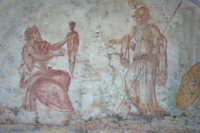 Untitled fresco “Roman fresco depicting Prometheus creating man in the presence of Athena, from the arcosolium of a tomb near the Basilica of St. Paul, 3rd century CE. (Museo della Via Ostiense, Rome).”
Untitled fresco “Roman fresco depicting Prometheus creating man in the presence of Athena, from the arcosolium of a tomb near the Basilica of St. Paul, 3rd century CE. (Museo della Via Ostiense, Rome).” -
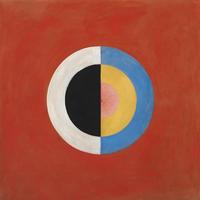 The Swan (No. 17) by Hilma af Klint
The Swan (No. 17) by Hilma af Klint
-
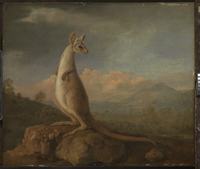 The Kongouro from New Holland A small kangaroo perched on a rock in left profile but looking back over its left shoulder, with a valley of light scrub behind backed by mountains and a cloudy sky.
The Kongouro from New Holland A small kangaroo perched on a rock in left profile but looking back over its left shoulder, with a valley of light scrub behind backed by mountains and a cloudy sky. -
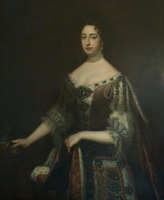 Portrait of Queen Mary II of England (1662 - 1694) Mary was born on April 30, 1662, during the reign of her uncle, Charles II. Her father, James, was first in line to the throne but he was Catholic, which made him unpopular in England. As a result, Charles required Mary to be raised as a Protestant. Three years later, James succeeded Charles, but he was deposed in the Glorious Revolution of 1688, where Mary and her husband as well as first cousin, William of Orange, succeeded him in 1689. Mary was devoted to her husband and reluctant to assume power in his absence, but she proved to be a strong and capable monarch when the need arose. The couple had no children; there is speculation that an early miscarriage permanently impaired Mary’s ability to have children. She was extremely devout and dedicated much of her time to ecclesiastical affairs. In addition, Mary endowed the College of William & Mary in 1692, helped found the Society for Promoting Christian Knowledge, and the Royal Hospital for Seamen. Mary was tall and apparently fit, but in 1694 she contracted smallpox. She died on December 28, 1694. William was devastated and reigned on as sole monarch until his death in 1702.
Portrait of Queen Mary II of England (1662 - 1694) Mary was born on April 30, 1662, during the reign of her uncle, Charles II. Her father, James, was first in line to the throne but he was Catholic, which made him unpopular in England. As a result, Charles required Mary to be raised as a Protestant. Three years later, James succeeded Charles, but he was deposed in the Glorious Revolution of 1688, where Mary and her husband as well as first cousin, William of Orange, succeeded him in 1689. Mary was devoted to her husband and reluctant to assume power in his absence, but she proved to be a strong and capable monarch when the need arose. The couple had no children; there is speculation that an early miscarriage permanently impaired Mary’s ability to have children. She was extremely devout and dedicated much of her time to ecclesiastical affairs. In addition, Mary endowed the College of William & Mary in 1692, helped found the Society for Promoting Christian Knowledge, and the Royal Hospital for Seamen. Mary was tall and apparently fit, but in 1694 she contracted smallpox. She died on December 28, 1694. William was devastated and reigned on as sole monarch until his death in 1702. -
 Portrait of King William III of England (1650 - 1702)
Portrait of King William III of England (1650 - 1702)
-
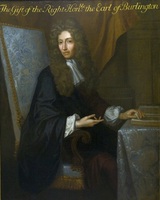 Portrait of Robert Boyle Donated by the sitter’s nephew, the Third Earl of Burlington, in 1732, this portrait of celebrated scientist Robert Boyle was the first work of art acquired by The College of William and Mary. Boyle was renowned for the discovery, later known as “Boyle’s Law,” of the mathematical relationship between the pressure and volume of a gas. Upon his death, funds from his estate at Brafferton Manor in Yorkshire, England, founded the first Indian school in the New World, located at the College and named “Brafferton” after Boyle’s manor house. James Worsdale, a student of Sir Godfrey Kneller, based this work on a 1689 portrait of Boyle by Johann Kerseboom, a German-born artist active in England in the late 17th century and the first decade of the 18th century.
Portrait of Robert Boyle Donated by the sitter’s nephew, the Third Earl of Burlington, in 1732, this portrait of celebrated scientist Robert Boyle was the first work of art acquired by The College of William and Mary. Boyle was renowned for the discovery, later known as “Boyle’s Law,” of the mathematical relationship between the pressure and volume of a gas. Upon his death, funds from his estate at Brafferton Manor in Yorkshire, England, founded the first Indian school in the New World, located at the College and named “Brafferton” after Boyle’s manor house. James Worsdale, a student of Sir Godfrey Kneller, based this work on a 1689 portrait of Boyle by Johann Kerseboom, a German-born artist active in England in the late 17th century and the first decade of the 18th century.